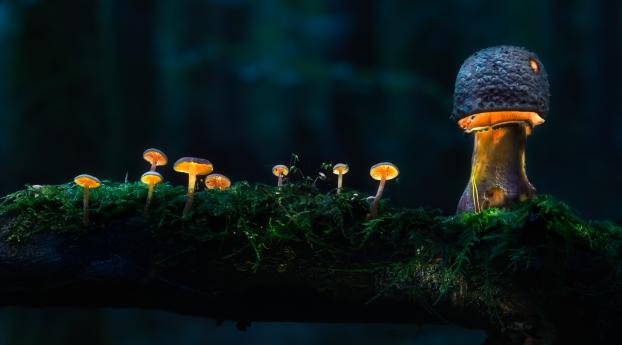
Mushroom growing is a fascinating and rewarding endeavor that allows us to tap into the wonders of nature. From the humble spores to the bountiful harvest, the process of cultivating mushrooms is both art and science. Whether you have a deep appreciation for the culinary delights that mushrooms bring or are simply intrigued by their mystical allure, mushroom growing offers an immersive and fulfilling experience.
When embarking on this journey, it is crucial to understand the intricacies involved in successfully cultivating mushrooms. Patience and attention to detail are essential as we delve into the realm of mycology, the study of fungi. From selecting the right mushroom species to creating the optimal growing conditions, every step plays a vital role in unlocking the magic of mushroom cultivation.
In this article, we will explore the various techniques and tools used in mushroom growing, providing you with practical tips and insights along the way. We will delve into the importance of substrate preparation, exploring different options such as straw, sawdust, or even coffee grounds. Understanding the life cycle of mushrooms, from inoculation to fruiting, will be key in ensuring a successful harvest. Additionally, we will discuss environmental factors such as humidity, temperature, and lighting that must be carefully regulated to create the ideal growing conditions.
Whether you are a seasoned mushroom cultivator or a curious beginner, this article will provide valuable knowledge and guidance to help you unleash the magic of mushroom growing. So grab your gardening gloves and join us on this enchanting journey, where the hidden world of fungi awaits to be explored and cultivated.
Choosing the Right Mushroom Species
When it comes to mushroom growing, selecting the right species is crucial for a successful cultivation journey. The wide variety of mushrooms available offer unique flavors, textures, and growing requirements. Here are some essential factors to consider when choosing the perfect mushroom species:
-
Climate and Growing Conditions: Different mushroom species thrive under specific climate and growing conditions. Some prefer cooler temperatures, while others require warmer environments. It is important to select a species that can easily adapt to the climate and conditions of your location.
-
Taste and Culinary Uses: Each mushroom species has its own distinctive flavor and culinary applications. Some are prized for their delicate taste and are perfect for gourmet dishes, while others have a stronger, earthy flavor that adds depth to savory recipes. Consider the taste profiles of different mushroom species to ensure they align with your culinary preferences.
-
Availability of Spawn or Spores: Availability of spawn or spores is another crucial aspect to consider. It is essential to choose a mushroom species for which you can easily obtain high-quality spawn or spores. This ensures a steady supply of the necessary materials for successful cultivation.
By carefully considering these factors, you can choose the ideal mushroom species that suits your climate, taste preferences, and availability of resources. In the next section, we will explore the fundamental aspects of preparing the substrate for mushroom cultivation.
Creating the Ideal Growing Environment
To successfully cultivate mushrooms, it is crucial to establish the ideal growing environment. This includes providing the right temperature, humidity, and air circulation.
Temperature plays a significant role in mushroom growth. Most varieties thrive in temperatures ranging from 60 to 75 degrees Fahrenheit (15 to 24 degrees Celsius). It is essential to monitor and maintain a consistent temperature throughout the growing process. Fluctuations can hinder growth and result in unsuccessful yields.
Humidity is another vital factor to consider. Mushrooms require a humid environment to develop properly. Aim for a humidity level of around 90% to 95% during the initial growing stages. As the mushrooms enter the fruiting phase, gradually decrease the humidity to around 85%. Proper humidity levels promote healthy growth and help prevent contamination.
In addition to temperature and humidity, adequate air circulation is crucial for mushroom cultivation. Mushrooms require fresh air to thrive and prevent the buildup of carbon dioxide. To achieve optimal air circulation, consider using fans or other means of ventilation in your growing space. This will help maintain a constant supply of oxygen and foster healthy mushroom development.
By creating an ideal growing environment with the right temperature, humidity, and air circulation, you can set the stage for successful mushroom cultivation. Next, we will explore the process of inoculating and caring for the mushroom spawn.
Harvesting and Enjoying Your Homegrown Mushrooms
Once your mushrooms have fully developed, it’s time to harvest and savor the fruits of your labor. Harvesting your homegrown mushrooms at the right time is crucial for flavor and texture. Here are some tips to help you get the most out of your mushroom harvest.
-
Timing is Key: Wait until the mushroom caps have fully opened and separated from the stem before harvesting. This indicates that the mushrooms are mature and ready to be picked. Avoid harvesting them too early as they may not have developed their full flavor and may still be attached to the stem.
-
Gentle and Delicate: When harvesting your mushrooms, handle them with care to avoid damaging the delicate caps and stems. Using a sharp knife or a pair of scissors, cut the mushrooms off at the base of the stem. It’s important to cut them cleanly rather than pulling or twisting, as this can damage the mycelium and affect future yields.
-
Enjoying the Bounty: Once you’ve harvested your mushrooms, it’s time to enjoy them! The fresher the mushrooms, the better they taste, so consider cooking them right away to fully savor their natural flavors. From sautéing them in butter and garlic to adding them to soups, stir-fries, or pasta dishes, the possibilities are endless. Homegrown mushrooms can elevate any dish with their unique and earthy taste, providing a satisfying and rewarding experience.
Remember, mushroom cultivation is a continuous learning process, and each harvest presents an opportunity to refine your techniques and improve your yields. With patience and practice, you can unleash the magic of mushroom growing right in your own home and enjoy a bountiful supply of delicious and nutritious mushrooms.


